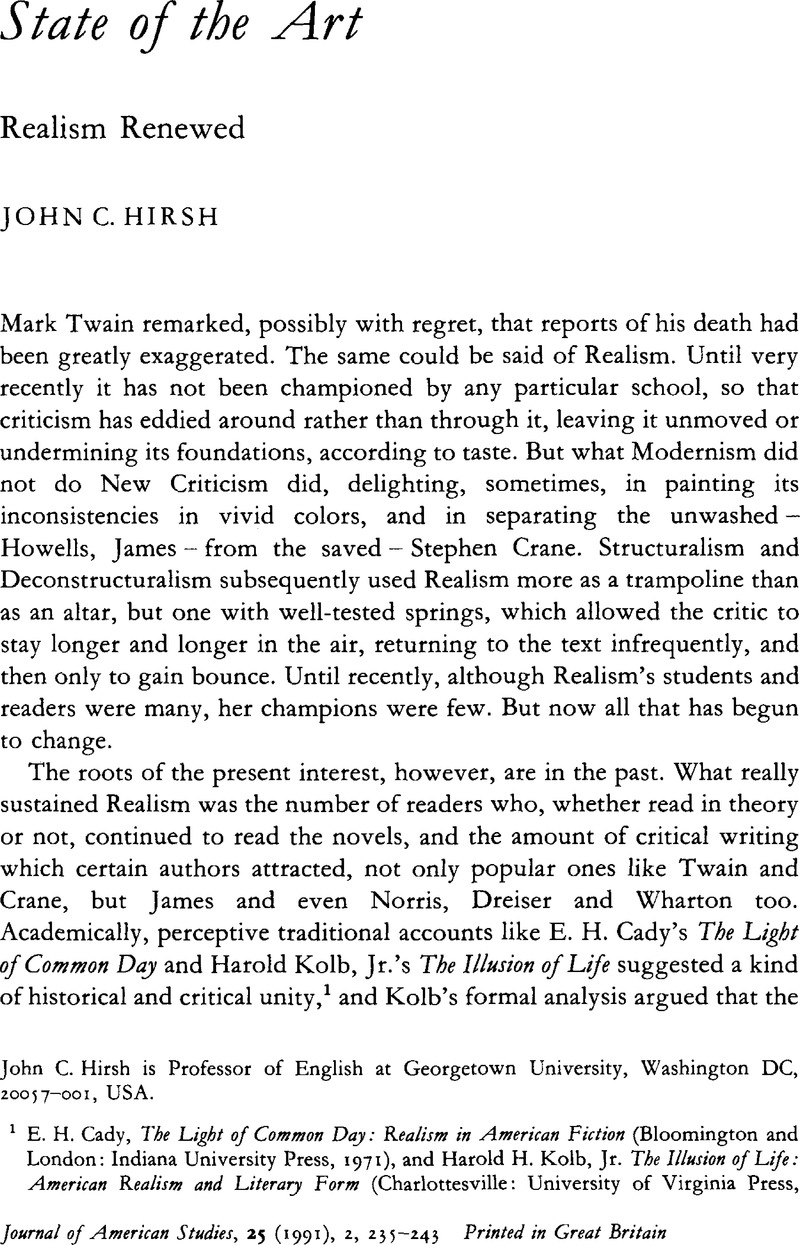No CrossRef data available.
Published online by Cambridge University Press: 16 January 2009

1 Cady, E. H., The Light of Common Day: Realism in American Fiction (Bloomington and London: Indiana University Press, 1971)Google Scholar, and Kolb, Harold H. Jr., The Illusion of Life: American Realism and Literary Form (Charlottesville: University of Virginia Press, 1968)Google Scholar See also Pizer, Donald, Realism and Naturalism in Nineteenth-Century American Literature, revised edition, Crosscurrents/Modern Critiques/New Series (Carbondale and Edwardsville: Southern Illinois University Press, 1984), the first edition of which appeared in 1966.Google Scholar
2 Pizer, Donald, “Harold H. Kolb, Jr.'s Study of American Realism as a Literary Form,” Genre, 3 (1970), 376–78. The quotation is from p. 377.Google Scholar
3 American Realism: New Essays, ed. Sundquist, Eric (Baltimore: Johns Hopkins University Press, 1982)Google Scholar Elsewhere, Sundquist's own reading of Realism stresses its reaction to the transformation of “land into capital, of raw materials into products, of agrarian values into urban values, and of private experience into public property,” The Columbia Literary History of the United States, ed. Elliott, Emory et al. (New York: Columbia University Press, 1988), 501Google Scholar. But the effect of these developments on the traditions of authorship are only now beginning to be understood.
4 See Kazin, Alfred, On Native Grounds: An Interpretation of Modern American Prose Literature (New York: Doubleday Anchor Books, 1942, rpt. 1956), 25–36, 378–406.Google Scholar
5 Kaplan, Amy, The Social Construction of American Realism (Chicago: The University of Chicago Press, 1988)Google Scholar, and Borus, Daniel H., Writing Realism: Howells, James, and Norris in the Mass Market (Chapel Hill and London: University of North Carolina Press, 1989).Google Scholar
6 This emphasis on Realism's concern for the common citizen is sometimes lost sight of, though it is apparent in its intellectual and artistic roots. See the recent monograph by Abélès, Luce with Lacambre, Geneviève, Champfleury, L'art pour le peuple, Les dossiers du musée d'Orsay 39 (Paris: réunion des musées nationaux, 1990).Google Scholar
7 See Nicholls, Peter, “Old Problems and the New Historicism,” in this journal, 23 (1989), 423–34Google Scholar. Nicholls points out that the term began “to define a particular critical approach by the English Renaissance scholar, Stephen Greenblatt in 1982” (423), and suggests that from a British perspective the developments “seems a little less controversial than they have done in America” (428).
8 Dreiser, Theodore, Dreiser Looks at Russia (New York: Horace Liveright, 1928), 9Google Scholar. The theme remained with him. See my “Tragic America: Dreiser's American Communism and a General Motors Executive,” Dreiser Newsletter, 13 (1982), 10–16.Google Scholar
9 Crowley, John W., The Mask of Fiction: Essays on W. D. Howells (Amherst: The University of Massachusetts Press, 1989). Pp. xv + 266, ISBN 0 87023 674 1, $27.50 or £18.50. Distributed in Britain by Eurospan, Ltd., 3 Henrietta St., London WC2.Google Scholar
10 Vita-Finzi, Penelope, Edith Wharton and the Art of Fiction (London: Pinter Publishers, 1990). Pp. vii + 172, ISBN 0 86187 793 4, £27.50Google Scholar. Another recent and very interesting study which uses traditional methodology in an unusual way is Peter G. Beidler's new reading of James's The Turn of the Screw which traces the theme of possession in the novel by way of a penetrating and extensive study of the “ghost” literature upon which the novel is based: Beidler, Peter G., Ghosts, Demons and Henry James: The Turn of the Screw at the Turn of the Century (Columbia: University of Missouri Press, 1989).Google Scholar
11 Donovan, Josephine, After the Fall: The Demeter-Persephone Myth in Wharton, Gather and Glasgow (University Park and London: The Pennsylvania State University Press, 1989). Pp. ix + 198, ISBN 0 271 00649 8, $23.50.Google Scholar
12 Lee, Hermione, Willa Cather: A Life Saved Up (London: Virago Brooks, 1989). Pp. viii + 409, ISBN 0 86068 661 2, £12.99.Google Scholar
13 Cather Studies, ed. Rosowski, Susan J. (Lincoln [Nebraska] and London: University of Nebraska Press, 1990). Pp. xii + 189, ISBN 0 8032 3895 1, $25.Google Scholar
14 Halliburton, David, The Color of the Sky, A. Study of Stephen Crane, Cambridge Studies in American Literature and Culture (Cambridge: Cambridge University Press, 1989). Pp. 351, ISBN 0 521 36274 1, £30, $37.50.CrossRefGoogle Scholar
15 The story was first reported on the front page of the Washington Post for 8 April 1982 in a story (“Mark Twain School Trying to Censor Huck”) by Mike Sager. There were subsequent stories by Sager and others on 9, 12, 13, and 16 April. Between 1950 and 1985 there have been at least seventeen attacks on the novel, several of which were successful in having the book removed from classroom use. Burress, Lee, Battle of the Books: Literary Censorship in the Public Schools 1950–1985 (Metuchen, N. J. and London: The Scarecrow Press, Inc., 1989), 208–09Google Scholar Such attacks show no sign of letting up. See Demac, Donna A., Liberty Denied: The Current Rise of Censorship in America (New Brunswick and London: Rutgers University Press, 1990), 7–22.Google Scholar
16 See the letter by Kevin Barr in “Cooper Championed Native Americans Against White Injustice,” New York Times for 25 10, 1990, A 26Google Scholar. A related study which sought to treat (among other things) “the social and cultural contexts that surround the teaching of literature” in American high schools is Literature in the Classroom: Readers, Texts and Contexts, ed. Nelms, Ben F., NCTE Forum Series (Urbana, Ill.: National Council of Teachers of English, 1988).Google Scholar